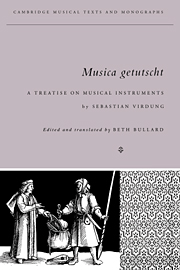Book contents
- Frontmatter
- Contents
- Preface
- List of abbrevations
- PART I TRANSLATOR'S INTRODUCTION
- 1 Why study Musica getutscht?
- 2 A biography of Sebastian Virdung
- 3 The publication history of Musica getutscht
- 4 The offspring of Musica getutscht
- PART II MUSICA GETUTSCHT
- Appendix Transcriptions of documents pertaining to Sebastian Virdung and Musica getutscht
- Notes
- Bibliography
- Index
1 - Why study Musica getutscht?
Published online by Cambridge University Press: 14 August 2009
- Frontmatter
- Contents
- Preface
- List of abbrevations
- PART I TRANSLATOR'S INTRODUCTION
- 1 Why study Musica getutscht?
- 2 A biography of Sebastian Virdung
- 3 The publication history of Musica getutscht
- 4 The offspring of Musica getutscht
- PART II MUSICA GETUTSCHT
- Appendix Transcriptions of documents pertaining to Sebastian Virdung and Musica getutscht
- Notes
- Bibliography
- Index
Summary
When Sebastian Virdung, a musician and priest from the city of Amberg, presented his draft for Musica getutscht to the Basel printer Michael Furter in 1510 or 1511, both were no doubt aware that they had something new to give the German-speaking world. For this little treatise is the first printed work in the West dealing exclusively with musical instruments. Indeed, a remarkable portion of its contents consists of material that appeared in print for the first time. These include the following: illustrations of musical instruments in current use arranged by organological categories, German keyboard tablature, German lute tablature, recorder fingering charts, and instructions with diagrams on aspects of instrumental performance practice. In addition, this is one of the earliest works on music in a vernacular tongue. (The short title by which it is known, combining the Latin Musica with the German getutscht, means “A treatise on music written in German.”) By virtue of its anteriority in so many respects, therefore, Musica getutscht is assured a place among the important documents of music history. As such, it is worthy of study for its own sake. Moreover, since Musica getutscht acted as a major generative force in a proliferation of instrumental tutors during the sixteenth century, it demands consideration as well for its seminal role.
- Type
- Chapter
- Information
- Musica GetutschtA Treatise on Musical Instruments (1511) by Sebastian Virdung, pp. 3 - 24Publisher: Cambridge University PressPrint publication year: 1993



